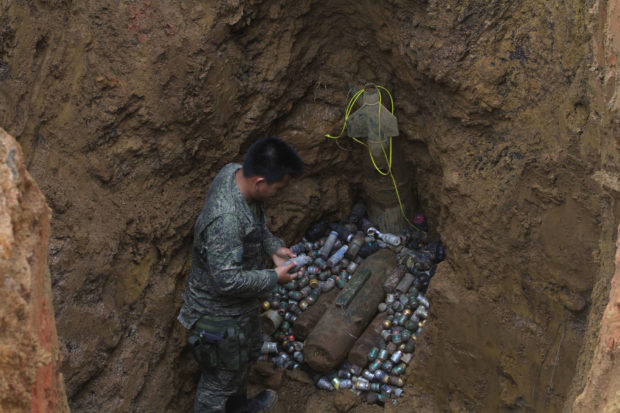MARAWI CITY — Authorities overseeing the reconstruction of this war-ravaged city are still searching for 46 more bombs that could be hidden underneath piles of debris left by the five-month long war against Islamic State-linked militants that ended in October 2017.
Army Col. Rene Sebastian, commander of Joint Task Group Builder that is in charge of debris-clearing, said the bombs were mostly dropped by Philippine Air Force planes against enemy positions during the war.
On Saturday (Aug. 3) the military detonated a host of unexploded ordnance found in various parts of Marawi’s urban area which is the scene of fierce fighting throughout the war.
A 260-lb bomb stuck nine meters in the ground was detonated at the village of Moncodo Colony. A pit was dug to expose a portion of the bomb.
Scores of other ordnance, like a 110-lb bomb, mortar and artillery projectiles, and grenades, were lowered into the pit, covered with soil and blasted around 11 a.m. Saturday.
The 260-ln and 110-lb bombs were the ordnance set for detonation and the smaller ones were expected to also shatter into pieces when the big ones exploded.
The last time an unexploded bomb was detonated was on June 26, a Wednesday, sending out a loud sound and shockwaves around the detonation area.
The exercise drew criticisms from Marawi residents, prompting the Task Force Bangon Marawi (TFBM), which is overseeing rehab and reconstruction work, to suspend ordnance disposal.
During Saturday’s detonation, the impact was contained by the nine-meter high natural wall of the pit. The blast sent soil up as high as 30 meters from the ground.
Sebastian said the projectiles that were blasted off Saturday were fired by both government forces and the terrorists.
The 260-lb bomb was discovered on July 23, the fifth find since March.
Sebastian said the search for remaining bombs will continue in coordination with Eddmari Construction and Trading, Inc., the private firm contracted by the government to clear the war debris in Marawi.
The TFBM divided the 250-hectare war-ravaged zone into nine sectors for purposes of clearing.
Sebastian said only Sector 1 of the so-called most affected area (MAA) is open for visits by its former residents.
The eight other sectors are still off-limits as debris clearing and search for unexploded bombs and ordnance continue.
Assistant Secretary Felix Castro, TFBM field manager, reminded former Marawi residents that only those who have permits from the city government were allowed to visit their previous homes inside Sector 1. /TSB
